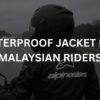No products in the cart.
How Malaysian Riders Should Prepare for Monsoon Season (2025)
Riding during the monsoon season in Malaysia means adjusting to sudden rain, slippery roads, fogged visors, and poor visibility, often all within the same ride with your motorcycle helmet strapped on top.
The southwest monsoon (May to September) and northeast monsoon (November to March) both bring unpredictable weather patterns across the country.
Let’s picture this, you leave your house under clear skies, and by the next traffic light, you’re soaked, dodging puddles and hoping your brakes bite. Sound familiar?
This guide walks through the key things Malaysian riders need to watch out for during the monsoon season, and how to prepare to stay safe through it all.
Table of Contents
ToggleMonsoon Season Hazards Riders Should Watch For
Hazard | What to Expect | How to Prepare |
Sudden Downpours | Clear morning turns into heavy rain by 3PM | Check rainfall radar apps or MetMalaysia before heading out |
Slippery Painted Surfaces | Lane markings and zebra crossings become slick | Reduce lean angle and use engine braking |
Fogged-Up Visors | Visor mists up in rain or cool hill rides | Leave visor slightly open or use anti-fog |
Flash Floods | Low-lying roads in cities fill quickly | Avoid underpasses during or after rainfall |
Poor Visibility at Night | Rain plus glare from oncoming traffic | Stick to well-lit routes and reduce speed |
Delayed Delivery Times | Courier riders face slower ETAs and wet handoffs | Communicate proactively with customers |
Why Malaysian Rain Is So Hard to Predict
You check your weather app, there is a 10% chance of rain or at least precipitation. One hour later, you’re drenched at a traffic light and wishing you brought your rain jacket instead of just your helmet motor.
Malaysia’s climate is driven by fast-moving air currents, terrain changes, and coastal effects. The southwest monsoon brings heavy showers mostly in the afternoons, especially on the west coast, affecting KL, Penang, Johor, and Melaka.
The takeaway? The rain doesn’t follow your schedule, but you can prepare for its patterns.
“According to METMalaysia, the southwest monsoon in 2024 brought 20–30% more afternoon rainfall in west coast states compared to previous years. This trend is expected to continue in 2025, especially in KL, Selangor, and Penang.”
How to Plan Safer Rides During the Monsoon
Leave earlier, ride slower, and adjust your routes.
- Start your ride earlier than usual, especially if commuting to work or making deliveries before 5PM.
- Use main roads or highways with working streetlights and visible lane markings.
- Avoid shortcuts through low-lying areas, many underpasses flood quickly and unpredictably.
- If possible, avoid underground carparks, waters would just channel through it.
Tip: Use apps like MyCuaca (by METMalaysia) or RainViewer for short-term rainfall tracking.
What Riders Should Check Before Heading Out
A quick pre-ride check can mean the difference between a smooth trip and a breakdown in the rain.
Before riding in monsoon weather, take a minute to go through this rider-friendly checklist.
1. Are your brakes responsive in the wet?
Brake pads that feel fine in dry conditions may lose bite when soaked.
- Test both front and rear brakes gently in a safe area
- If they feel soft or uneven, avoid high-speed riding and get them serviced
2. Do Your Tyres Still Have Enough Tread?
Worn-out tyres won’t channel water properly, increasing your risk of skidding.
- Look for at least 2mm of tread depth
- Avoid slick or hardened rubber, they lose grip faster on wet roads
3. Does Your Visor Fog Up Easily?
Fogging reduces visibility exactly when you need it most.
- Crack your visor open slightly to improve airflow
- Use anti-fog film or spray if you ride through cooler zones or rain-prone areas
4. Is Your Rain Layer Easy To Access And Put On?
There’s no point carrying a raincoat you can’t wear in 30 seconds.
- Keep it stored at the top of your pouch or waist bag
- Choose one that’s compact, lightweight, and designed for riding posture
5. Do You Know Where The Floods Usually Happen On Your Route?
Familiar roads can turn hazardous quickly when water builds up.
- Avoid underpasses, narrow roads, or poorly drained areas
- Use Waze or RainViewer for crowd-sourced flood alerts and reroute options
Prepared riders reduce risk not just for themselves, but for others too.
Checking your gear and route before you leave helps prevent mid-ride panic, sudden stops, or dangerous manoeuvres, all of which affect everyone on the road around you.
How to Ride Safely During the Monsoon
- Lower your average speed, even on familiar routes.Slower speeds give you more time to react to flooded sections, stalled cars, or fallen debris.
- Use engine braking instead of sudden lever pulls. Releasing the throttle gradually helps reduce speed without relying heavily on the brakes.
- Avoid sudden swerves and deep lean angles.Sharp turns or sudden lane changes are harder to control on wet surfaces.
- Brake earlier than usual and more gently. Wet brake pads and rotors don’t grip immediately. Give them time.
- Stay aware of vehicles behind you.Your brake light might not be clearly visible in rain or low light.
“Know when to pause under a flyover, reroute, or just wait it out. Your goal is to arrive, not to prove a point.”
Common Mistakes Riders Make During Monsoon Season
Overconfidence in dry-road habits leads to poor judgment on wet roads. Even experienced riders slip up when they don’t adapt to weather conditions. Here are the most common missteps:
- Wearing dark clothing in low visibility: Makes it harder for other vehicles to see you.
- Braking too late or too hard: Causes wheel lock or skids, especially on paint and manhole covers.
- Assuming flood depth: If you can’t see the bottom or other bikes crossing, don’t chance it.
- Ignoring helmet maintenance: A fogged or scratched visor reduces visibility just when you need it most.
- Skipping post-ride checks: Wet chains, brake pads, and electronics need extra care after heavy rain.
What to Do If You Get Caught in a Flood While Riding
If water rises quickly, don’t panic, stay calm and assess.
- Turn off your engine immediately if water reaches the exhaust level
- Push your bike to higher ground if possible
- Do not restart your engine in standing water, this may cause hydro-lock damage
- Dry your chain, brake discs, and plugs after exiting flood zones
- If the engine stalls mid-crossing, call for assistance instead of forcing a restart
Remember: Water over your ankle is already enough to cause mechanical issues.
Conclusion: A Monsoon Plan Is Just Part of Riding in Malaysia
Malaysian riders are already some of the most adaptive in Southeast Asia, and the monsoon season is just another condition we adjust for.
From checking radar apps before your commute to planning alternate routes in advance, the key is knowing how weather shapes the road beneath you.
At Pmax, we want every rider to get home safely, dry or not. That’s why we sell raincoat and other motorcycle accessories to help you manage through the storm and rain.
Frequently Asked Questions About Riding through the Monsoon Season
When Is The Monsoon Season In Malaysia?
From May to September (southwest monsoon) and November to March (northeast monsoon), depending on the region.
Is It Safe To Ride A Motorcycle During Monsoon Season?
Yes, if you plan properly, ride slower, and avoid known flood zones.
What Roads Flood The Most During Malaysia’s Monsoon?
Jalan Kuching, Jalan Raja Laut (KL), parts of Shah Alam, and downtown JB are common flood points.
How Can I Avoid Visor Fogging In The Rain?
Crack the visor slightly open or use anti-fog inserts or sprays before heading out.
Why Are Roads More Slippery After The First Rain?
Dust, oil, and debris build up during dry days and get lifted during first rainfalls, creating slick surfaces.
Which Weather Apps Help Malaysian Riders Track Rain?
Try RainViewer, MyCuaca (by METMalaysia), or Google Weather’s hourly radar.



